Human rights activists continue to flag China’s crackdown on Uyghurs at internment camps in Xinjiang, but the country’s Muslim allies, including Pakistan, are still looking away. Twice in the last three months, Pakistan Prime Minister Imran Khan has said “I don’t know much” when asked about the alleged crackdown on Uyghurs.
Question: what's your stance on China's treatment of Uyghur Muslims?
PM Khan: frankly, I don't know much about that.. pic.twitter.com/lNoNDdN6NX
— Naila Inayat नायला इनायत (@nailainayat) March 27, 2019
China’s Uyghurs see themselves as closer in culture and traditions to Central Asians than the country’s majority Han ethnicity. This has triggered tensions among locals, and China has blamed several instances of violence, including a knife attack in February 2017 that killed eight people, on Uyghur separatists.
Even as China continues to block UN sanctions against Pakistan-based chief Masood Azhar, whose terrorist group Jaish-e-Mohammed has repeatedly attacked India, it is said to have launched a massive campaign to quash Uyghurs’ faith in Islam, justifying it as a crackdown on extremism, terrorism and separatism.
Last month, the Communist Party of China expelled a high-ranking Uyghur official over alleged corruption, making him the latest casualty of President Xi Jinping’s years-long crackdown on political corruption. In a statement, China’s anti-corruption watchdog said it would prosecute Nur Bekri, Reuters reported.
As governor of Xinjiang, where most of China’s Uyghurs are based, between 2008 and 2014, Bekri was reportedly part of the official machinery involved in efforts to dissociate the primarily-Muslim community from its Islamic roots.
The latest manifestation of China’s crackdown is what it calls “vocational education centres”, which human rights activists allege are massive internment camps where Uyghurs are made to learn Mandarin and renounce Islam.
‘Re-wire political thinking’
China has established more than 21 ‘political re-education centres’ in its Xinjiang Uyghur region, to “re-wire the political thinking of detainees” who are largely Muslim Uyghurs, according to depositions by a US Congressional Executive Commission.
The ‘political re-education centres’ — modern China’s version of erstwhile Soviet-era Gulags — have expanded in recent months. The expansion has coincided with the tenure of Chen Quanguo, who was appointed to head the Communist Party of China (CPC) in the region two years ago.
ThePrint uses satellite imagery sourced from Google Earth to examine what is happening in Xinjiang, and focuses on one particular re-education centre.
Banning of 29 names
In April 2017, the Communist Party of China (CPC), which officially subscribes to atheism, issued a diktat — “Naming Rules For Ethnic Minorities”. It banned at least 29 names, including Muhammad, Islam, Jihad and Hajj.
Chinese authorities claimed the ban was imposed because of “divided consciousness and religious consciousness”.
No baby born after 17 April 2017, can have a name from the proscribed list. Persons born earlier had to drop these names from their official documents.
A most interesting decision to drop the name Muhammad came from the Chinese deputy chief of mission in Pakistan, who changed his Twitter name from ‘Muhammad Lijian Zhao’ to ‘Lijian Zhao’.
Also read: China builds defences in PoK territory India claims, carries out joint patrols with Pakistan
Gulags in Xinjiang
Chen Quanguo, after impressing with his performance in Tibet, took charge as the CPC secretary responsible for Xinjiang Uyghur in August 2016. The ‘re-education’ schools were begun and expanded under his watch. They are basically detention centres for political indoctrination.
People who toe the CPC line and agree to government diktats are dealt with leniently. Others are either punished, tortured or put in prison without charges.
There are at least 28 such schools built under the leadership of Chen Quanguo, noted the US Congressional deposition, citing data surveillance.
The biggest of these is in Shule County, 15 km southwest of Kashgar, the largest Uyghur city.
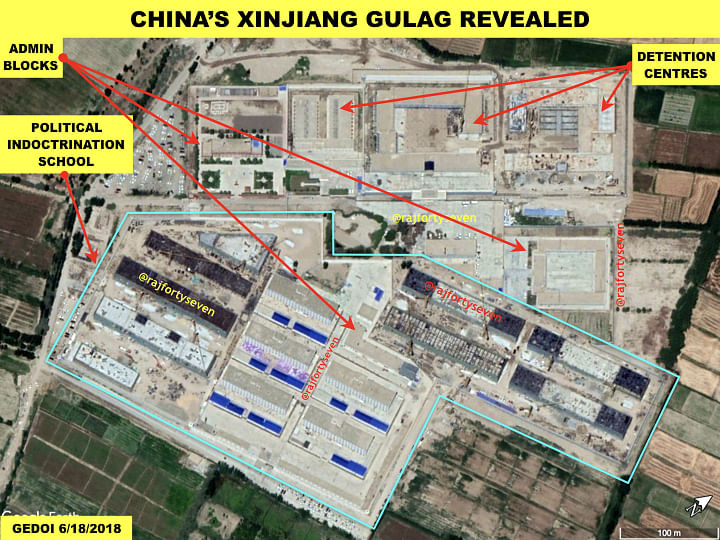
The facility began as a small jail for politically ‘incorrect’ prisoners in 2009. Till the arrival of Chen Quanguo in 2016, it was a minor establishment.
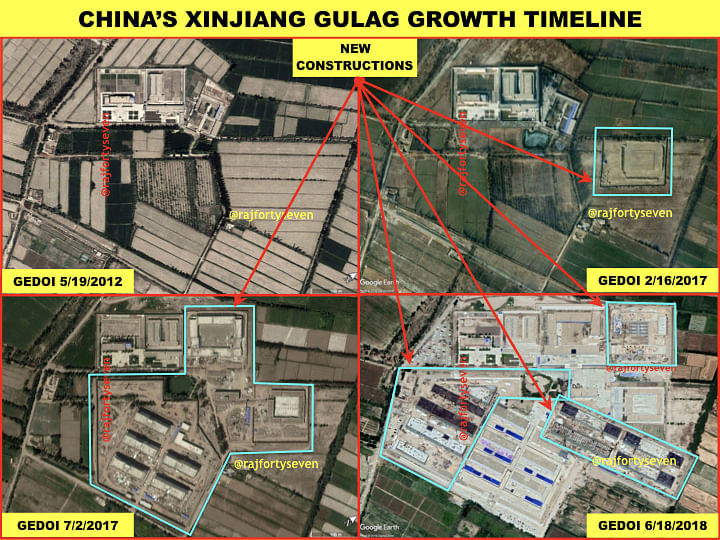
This particular facility has grown remarkably since early 2017, around the time when the cultural diktat on names was issued.
Construction
The construction of the facility is unique. The basement was built and then filled with compressed earth. This is probably done to ensure that inmates cannot dig tunnels through its walls or floors to escape.
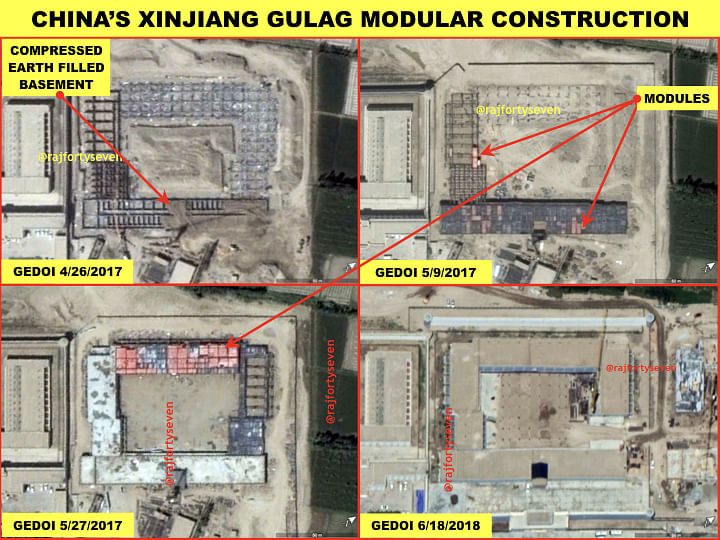
The buildings are constructed with modular techniques, using prefabricated steel braces that were implanted with cranes and earthmovers.
Individual modules also have steel frames that strengthen the buildings.
This permits speedy construction of buildings at a cheaper rate since most work is done by machines that are faster compared to manual labour.
Also read: China’s new, secret missile garrison in Sichuan can target all of India and beyond
Size and shape
In June 2017, one rectangular double-storeyed prison building was completed. It measures 102m x 80m, and is possibly used to keep political prisoners.
Right opposite this complex is one which possibly houses the ‘re-education school’. It measures 70m x 15m, and features four-storeyed structures with 21 windows on each floor, indicating 42 rooms of 6m x 3m.
Another single-storeyed building possibly serves as an administrative barracks.
Thus, at any time, a minimum of 800 so-called “students” could be accommodated in 2017.
The latest Google Earth image, from 18 June 2018, shows that an additional rectangular double-storeyed prison building (of the exact same size as the previous one) is being constructed, as are seven more “re-education” school buildings of 130m x 20m size.
These new buildings would increase the capacity to at least 3,000 inmates.
The rectangular buildings with maximum security are likely to be detention centres for political prisoners.
Security
The entire facility is surrounded by a triple-layered fence, with the one in the middle being solid 1.75m thick and almost 10m tall.
Most turnings have a covered circular sentry post on top. There is a path for movement between the posts.
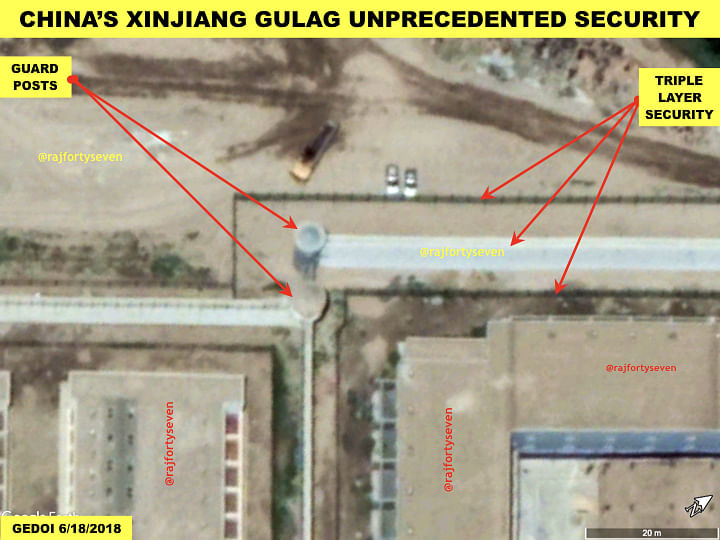
The inner and outer fences are made of barbed-wire, approximately 4m high.
Beijing is enforcing a culture in such fortress-prisons that could wipe out people’s own markers of faith and unique way of life. This is how ethnic cleansing takes shape.
This is an updated version of a report originally published on 1 August 2018.


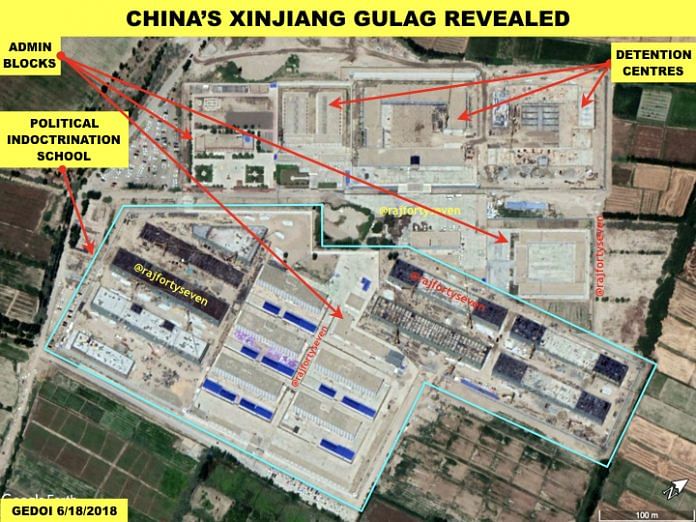

Best idea I have seen in a long time. Excellent work China. No terrorist attacks there.